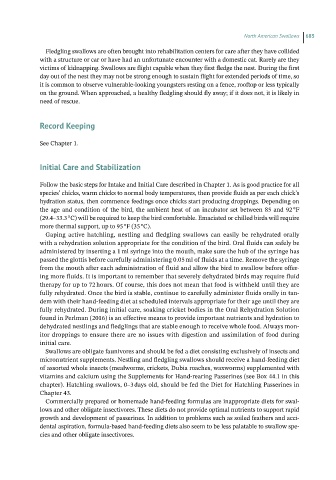Page 684 - Hand rearing birds second
P. 684
North American Swallows 685
Fledgling swallows are often brought into rehabilitation centers for care after they have collided
with a structure or car or have had an unfortunate encounter with a domestic cat. Rarely are they
victims of kidnapping. Swallows are flight capable when they first fledge the nest. During the first
day out of the nest they may not be strong enough to sustain flight for extended periods of time, so
it is common to observe vulnerable‐looking youngsters resting on a fence, rooftop or less typically
on the ground. When approached, a healthy fledgling should fly away; if it does not, it is likely in
need of rescue.
RecordKeeping
See Chapter 1.
InitialCareand Stabilization
Follow the basic steps for Intake and Initial Care described in Chapter 1. As is good practice for all
species’ chicks, warm chicks to normal body temperatures, then provide fluids as per each chick’s
hydration status, then commence feedings once chicks start producing droppings. Depending on
the age and condition of the bird, the ambient heat of an incubator set between 85 and 92 °F
(29.4–33.3 °C) will be required to keep the bird comfortable. Emaciated or chilled birds will require
more thermal support, up to 95 °F (35 °C).
Gaping active hatchling, nestling and fledgling swallows can easily be rehydrated orally
with a rehydration solution appropriate for the condition of the bird. Oral fluids can safely be
administered by inserting a 1 ml syringe into the mouth, make sure the hub of the syringe has
passed the glottis before carefully administering 0.05 ml of fluids at a time. Remove the syringe
from the mouth after each administration of fluid and allow the bird to swallow before offer -
ing more fluids. It is important to remember that severely dehydrated birds may require fluid
therapy for up to 72 hours. Of course, this does not mean that food is withheld until they are
fully rehydrated. Once the bird is stable, continue to carefully administer fluids orally in tan-
dem with their hand‐feeding diet at scheduled intervals appropriate for their age until they are
fully rehydrated. During initial care, soaking cricket bodies in the Oral Rehydration Solution
found in Perlman (2016) is an effective means to provide important nutrients and hydration to
dehydrated nestlings and fledglings that are stable enough to receive whole food. Always mon-
itor droppings to ensure there are no issues with digestion and assimilation of food during
initial care.
Swallows are obligate faunivores and should be fed a diet consisting exclusively of insects and
micronutrient supplements. Nestling and fledgling swallows should receive a hand‐feeding diet
of assorted whole insects (mealworms, crickets, Dubia roaches, waxworms) supplemented with
vitamins and calcium using the Supplements for Hand‐rearing Passerines (see Box 44.1 in this
chapter). Hatchling swallows, 0–3 days old, should be fed the Diet for Hatchling Passerines in
Chapter 43.
Commercially prepared or homemade hand‐feeding formulas are inappropriate diets for swal-
lows and other obligate insectivores. These diets do not provide optimal nutrients to support rapid
growth and development of passerines. In addition to problems such as soiled feathers and acci-
dental aspiration, formula‐based hand‐feeding diets also seem to be less palatable to swallow spe-
cies and other obligate insectivores.

